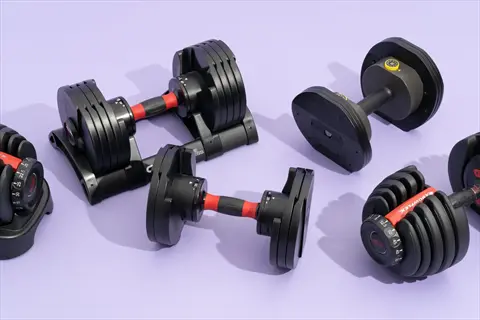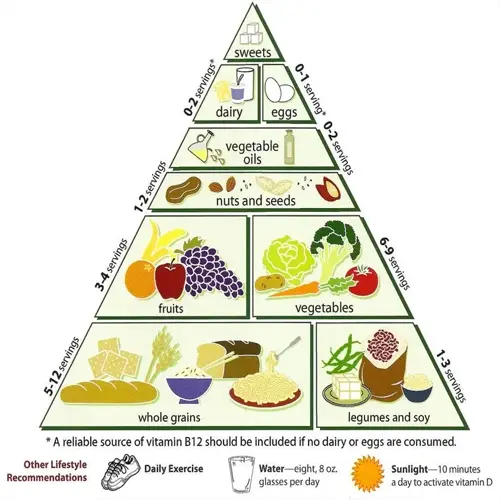Transform Your Life: Nutrition and Wellness Essentials

Written by
David Nelson
Reviewed by
Prof. William Dalton, Ph.D.Integrating nutrition and wellness helps prevent diseases, by making sure you make healthy food choices.
Personalized meal plans help you to consider your dietary requirements and budget.
There are requirements associated with physical activity that include aerobic, strength, flexibility, and balance training.
Energy balance relates to eating and managing calories you have burned.
Debunk nutrition myths around meal timing as well as spot reduction.
Wellness as a whole consists of physical, mental, and social health.
Article Navigation
Nutrition and wellness are the foundation of a healthy life. Together, they help support the body and mind. I have witnessed the transformation in my clients' energy levels when they prioritize this powerful connection. Good choices lead to good things for the long-term health of the body.
Understanding energy balance helps you determine how to maintain your ideal weight. Smart meal planning can help avoid some common diet pitfalls. We will help sort out nutrition myths that many people are confused about. This method enables long-term health without requiring highly restrictive practices.
These principles boost both daily vitality and long-term well-being. Simple changes create noticeable improvements in how you feel. Start applying these ideas today for a healthier tomorrow.
Food Safety Practices
For food safety, practice the Clean, Separate, Cook, Chill method. Wash your hands thoroughly before preparing ingredients. Use different cutting boards for raw meats and vegetables. This prevents dangerous cross-contamination in your kitchen. I use colored cutting boards for safe measuring and cutting during busy cooking times.
Drying methods have been used for thousands of years; salting and fermentation also enabled the preservation of food before the advent of electricity. Protection against spoilage is enhanced through refrigeration. Use care when handling high-risk foods. Raw poultry, eggs, and unpasteurized dairy products should be handled with special care. Keep them refrigerated until use.
Cook foods to their safe internal temperatures. Poultry should be cooked to an internal temperature of 165°F (74°C). Ground meats to 160°F (71°C). Use a good thermometer to check. Refrigerate leftovers within two hours. Refrigerators should be kept below 40°F (4°C) to
Storing food properly will prolong its freshness and prevent foodborne illness. Label containers with the date you stored them in the freezer or refrigerator. Place older items in the front when you buy new items. These small habits can help maintain your family member's well-being while also incorporating some nutrients into your meals.
Ancient Methods
- Drying removed moisture to inhibit bacterial growth in meats and fruits
- Salting created hostile environments for microbes through osmosis
- Fermentation used beneficial bacteria to preserve vegetables and dairy
- Smoking combined drying with antimicrobial compounds from wood
- Pickling preserved foods in acidic vinegar solutions
- Underground storage maintained cool temperatures year-round
Modern Techniques
- Refrigeration slows bacterial growth at 40°F (4°C) or below
- Freezing halts microbial activity at 0°F (-18°C)
- Pasteurization heats liquids to eliminate pathogens without altering taste
- Vacuum sealing removes oxygen to prevent spoilage microorganisms
- High-pressure processing kills pathogens without heat
- Irradiation uses controlled radiation to destroy microorganisms
Canning Innovations
- Pressure canning enables safe preservation of low-acid foods
- Water bath canning works for high-acid fruits and pickles
- Airtight seals prevent recontamination during storage
- Modern lids feature safety indicators for seal integrity
- Thermal processing times calibrated for pathogen elimination
- pH testing ensures proper acidity for food safety
Chemical Preservatives
- Nitrates prevent botulism in cured meats like bacon
- Sulfites inhibit browning in dried fruits and wines
- Sorbic acid controls mold growth in cheeses and baked goods
- Antioxidants like BHA prevent rancidity in oils and fats
- Benzoates target yeast and mold in acidic products
- Propionates specifically prevent mold in bread products
Dehydration Advances
- Freeze-drying preserves nutrients and flavor in lightweight foods
- Spray drying creates stable powders from liquids like milk
- Solar dehydration uses renewable energy for fruit preservation
- Osmotic dehydration infuses fruits with sugar solutions
- Electric dehydrators maintain precise low temperatures
- Vacuum microwave drying combines speed and efficiency
Physical Activity Integration
Aerobic exercise, like brisk walking, benefits your heart and burns calories. Strength training strengthens muscles and raises resting metabolic rate. Flexibility training keeps joints flexible, while balance practice reduces the chance of falls. Each contributes something special and flourishes together for full fitness.
Regulate your meal schedule to coincide with your workouts. Eat either a banana or oatmeal 30 minutes before the workout to energize yourself for exercise. After exercising, eat Greek Yogurt or eggs within 45 minutes of your workout. This helps in the recovery of muscle & replenishing energy. I eat protein-enriched snacks after workouts to maximize results.
Start manageable routines. Start your aerobic workouts with 10-minute walks twice a day, then progress to 30-minute runs. For strength, master bodyweight squats, then progress to using weights. Flexibility improves through 5-minute stretches, then yoga flows. Balance improves through chair-directed standing exercises and single-leg exercises.
Different activities burn different numbers of calories. Cycling can burn between 300 and 450 calories (1,250 to 1,900 kJ) per hour. Swimming burns 180-266 calories (750-1100 kJ). Weight training takes 90-135 calories (375-565 kJ) in 30 minutes. Vary the intensity to fit your fitness level.
Aerobic Training
- Cardiovascular health: Regular aerobic activity significantly improves heart and lung function while increasing oxygen circulation throughout the body
- Calorie expenditure: Burns approximately 300-600 calories per hour depending on intensity level and individual metabolic factors
- Common examples: Includes brisk walking, cycling, swimming, dancing and other rhythmic activities that elevate heart rate
- Recommended frequency: Minimum 150 minutes weekly of moderate-intensity exercise for substantial health benefits
- Beginner approach: Start with manageable 10-minute sessions twice daily to build endurance safely
- Progression strategy: Gradually increase duration before intensity to prevent overexertion and injury
Strength Training
- Muscle development: Builds lean muscle mass which naturally boosts resting metabolic rate over time
- Bone density improvement: Weight-bearing resistance exercises help prevent osteoporosis by stimulating bone growth
- Equipment examples: Resistance bands, free weights, weight machines and bodyweight exercises provide effective options
- Optimal frequency: 2-3 non-consecutive days weekly allows adequate muscle recovery between sessions
- Form fundamentals: Beginners should prioritize proper technique before increasing weight loads
- Progressive method: Add 5-10% weight when completing 12 repetitions becomes relatively easy
Flexibility Work
- Range of motion: Maintains joint mobility and prevents injuries by keeping connective tissues supple
- Recovery benefits: Reduces delayed onset muscle soreness and improves circulation post-workout
- Activity types: Yoga, Pilates, dynamic stretching routines and mobility drills enhance flexibility
- Daily practice: Short 5-10 minute sessions yield cumulative benefits without overwhelming beginners
- Basic technique: Hold static stretches 15-30 seconds without bouncing to avoid muscle strain
- Advanced methods: Incorporate proprioceptive neuromuscular facilitation techniques for deeper stretching
Balance Practice
- Fall prevention: Particularly crucial for older adults to maintain independence and prevent injuries
- Core engagement: Strengthens abdominal and back muscles while improving overall body awareness
- Exercise forms: Tai Chi, single-leg stands, balance board drills and stability ball work
- Weekly commitment: 3 sessions weekly develops neuromuscular coordination effectively
- Supported start: Beginners should use chair support during standing balance exercises initially
- Challenge progression: Close eyes during stable positions to increase difficulty safely
Recovery Techniques
- Muscle repair: Essential for tissue rebuilding and glycogen restoration after intense workouts
- Active recovery: Light movement like walking promotes circulation without additional strain
- Hydration focus: Replenishing fluids and electrolytes supports cellular function and recovery
- Sleep importance: 7-9 hours nightly enables crucial hormonal balance and tissue repair
- Nutrition timing: Protein-rich snacks within 45 minutes post-workout optimize muscle synthesis
- Foam rolling: Self-myofascial release reduces muscle tightness and improves flexibility

Resistance Bands
- Versatility: These elastic bands effectively replace traditional weights for comprehensive strength training routines targeting all major muscle groups
- Portability advantage: Their lightweight and compact design makes them exceptionally travel-friendly for consistent workouts anywhere
- Resistance levels: Color-coded bands typically provide progressive resistance from 5-200 pounds (2-90kg) for all fitness levels
- Beginner selection: Light tension bands offering 10-15 pounds (4-7kg) of resistance are ideal for newcomers to resistance training
- Advanced options: Heavy tension tubes with ergonomic handles allow experienced users to perform challenging compound movements safely
- Exercise applications: Effective for band rows, squats, chest presses, and hundreds of other functional movement patterns

Yoga Mat
- Joint protection: The cushioned surface protects knees, elbows and spine during floor exercises and stretching routines
- Non-slip surface: Textured materials provide essential stability and security during balance-intensive poses and movements
- Standard dimensions: Most mats measure 68-72 inches long (173-183cm) to accommodate various body heights comfortably
- Thickness variations: Options range from 3-6mm to provide different cushioning levels based on personal preference and joint sensitivity
- Eco-conscious choices: Natural rubber and recyclable materials offer sustainable alternatives to conventional PVC mats
- Multi-disciplinary use: Suitable for yoga, Pilates, core workouts, stretching routines and meditation practices

Adjustable Dumbbells
- Space efficiency: These innovative sets replace multiple individual weights saving significant storage space in home gyms
- Weight versatility: Typically offering 5-50 pounds (2-23kg) per dumbbell to cover full-body strength requirements
- Quick-adjust mechanism: Dial systems enable seamless weight changes between exercises without interrupting workout flow
- Beginner recommendation: Starting with 5-10 pounds (2-5kg) allows newcomers to master proper form before progressing
- Strength progression: Increasing resistance by 5-10% weekly provides optimal stimulus for continued muscle development
- Compound movements: Ideal for goblet squats, overhead presses, rows and other functional strength-building exercises

Jump Rope
- Calorie efficiency: This simple tool burns approximately 15-20 calories per minute making it exceptionally time-efficient
- Length adjustment: Proper sizing occurs when standing on rope center with handles reaching armpit height
- Performance variations: Weighted ropes build endurance while speed ropes develop quickness and coordination
- Impact management: Using mats or cushioned surfaces reduces joint stress during high-intensity skipping sessions
- Skill development: Beginners start with basic bounces before advancing to crosses, doubles and complex footwork
- Travel convenience: Compact design fits easily in bags for effective cardio workouts anywhere with clearance

Stability Ball
- Core activation: The unstable surface engages abdominal muscles continuously during all exercises performed on it
- Size selection: Standard 55cm balls suit most adults between 5'6"-6' tall (168-183cm) for optimal positioning
- Safety features: Anti-burst materials safely support up to 600 pounds (272kg) during dynamic movements
- Posture improvement: Encourages proper spinal alignment during seated work and functional movement patterns
- Exercise versatility: Effectively used for crunches, planks, bridges, and even as a supportive desk chair
- Beginner technique: Partially deflating the ball creates greater stability when first learning exercises
Personalized Meal Planning
The MyPlate model is adjustable to any lifestyle. For vegetarians, lentils or quinoa can serve as a substitute for meat to provide a complete protein source. For athletes, starches like sweet potatoes are added to offer extra carbohydrates for use before training. Both situations give balanced nutrition without sacrificing important nutrients. I prepare plates for clients according to their individual needs.
Inspect meals using simple methods. Check protein with the palm rule, so one palm-sized serving per meal. Fill half your plate with veggies to check veggies. Micronutrients: colorful veggies every day. There are apps that can check vitamins, but eating whole foods is the best absorption.
Save money by switching to more affordable foodstuffs. Substitute sunflower seeds for expensive nuts in salads. Instead of using fresh, out-of-season fruits, use frozen berries as a substitute. Buy whole chickens instead of cuts of breast meat. A 5lb bird produces 3lbs (1.4kg) of meat at a lower cost.
Improve efficiency in meal prep with batch cooking! Roast 5lbs (2.3kg) of vegetables while cooking grains at the same time. Divide these into 1-cup (240ml) containers for easy grab and go meals. An ice-cube tray is the perfect way to freeze sauces: one ice-cube is equivalent to two tablespoons (30ml). Spending two hours a week cooking and freezing saves that precious time every day!
Vegetarian Adaptations
- Protein alternatives: Combine legumes (lentils, chickpeas) with whole grains for complete amino acid profiles
- Iron sources: Pair spinach with vitamin C-rich foods like bell peppers to enhance absorption
- Calcium solutions: Use fortified plant milks or calcium-set tofu to meet daily requirements
- Omega-3 options: Incorporate chia seeds, flaxseeds, and walnuts for essential fatty acids
Athlete Nutrition
- Carbohydrate timing: Consume 30-60g carbs/hour during endurance activities exceeding 60 minutes
- Protein distribution: Spread 20-40g portions every 3-4 hours for muscle synthesis
- Hydration protocol: Replace 150% of sweat loss post-exercise with electrolyte solutions
- Recovery meals: Combine carbs and protein in 3:1 ratio within 45 minutes post-workout
Family Meal Balancing
- Batch cooking: Prepare 2x portions for freezer storage reducing weekly cooking time
- Customizable bases: Serve grain bowls with separate protein/veggie components
- Nutrient density: Add grated zucchini/carrots to sauces and baked goods
- Portion scaling: Use hand measurements: palm=protein, fist=veggies, cupped hand=carbs
Diabetic Adaptations
- Carb control: Limit portions to 45-60g per meal using measuring cups (180-240ml cooked grains)
- Fiber focus: Include 8-10g fiber per meal with vegetables and whole grains
- Healthy fats: Add avocado or olive oil (1-2 tbsp/15-30ml) to slow glucose absorption
- Consistent timing: Eat meals within 30-minute windows daily for stable blood sugar
Senior Nutrition
- Protein priority: 25-30g per meal from eggs, fish, or tender meats (3-4oz/85-113g)
- Calcium focus: Include dairy or fortified alternatives (1 cup/240ml) twice daily
- Easy-to-chew options: Choose cooked vegetables over raw; ground meats instead of steak
- Hydration reminder: Drink 8 glasses (64oz/1.9L) water daily with timed reminders
Cost-Saving Strategies
- Seasonal buying: Purchase produce at peak season freezing extras for off-season use
- Bulk proteins: Buy whole chickens or large meat cuts portioning into meal-sized bags
- Plant-based meals: Implement 2 meatless days weekly using lentils and beans
- Preservation: Blanch and freeze surplus vegetables preventing waste
Time Management
- Parallel prep: Roast vegetables while cooking grains and proteins simultaneously
- Mise en place: Pre-chop weekday ingredients storing in portioned containers
- Cook once/eat twice: Prepare double portions repurposing leftovers creatively
- 15-minute meals: Keep canned beans, frozen veggies and pre-cooked grains stocked
Recipe Adaptation
- Ingredient swaps: Replace expensive nuts with seeds like sunflower or pumpkin
- Global flavors: Use spices instead of pricey sauces for flavor depth
- Batch sauces: Make large quantities of tomato sauce freezing in ice cube trays
- Scaling technique: Adjust recipes to use whole packages avoiding partial ingredients
Seasonal Planning
- Monthly calendar: Align meals with seasonal produce availability for cost efficiency
- Preservation methods: Can or freeze summer berries for winter use (1lb/450g batches)
- Root vegetables: Utilize potatoes and carrots during colder months for bulk savings
- Herb gardens: Grow basil/mint indoors year-round saving $5-$10 weekly on fresh herbs
Leftover Reinvention
- Protein transformations: Shred leftover chicken (8oz/225g) for tacos or salads
- Grain remixes: Turn cooked rice into fried rice with frozen vegetables and eggs
- Vegetable soups: Blend roasted vegetables with broth for quick 10-minute soups
- Breakfast swaps: Use dinner potatoes in morning hash with eggs
Defining Nutrition and Wellness
Nutrition provides the body with essential nutrients through food. Wellness is concerned with overall balance in life. Nutrition is focused on physical fuel. Wellness encompasses the mind, body, and lifestyle choices. They work together to create true health. I help clients see how they complement each other.
Grasp macronutrients and micronutrients. Carbs in oats provide energy. The proteins in chicken build muscle. The fats in avocados support the hormones needed for health. The vitamins in berries are a necessary defense against illness. The minerals in spinach build strong bones. For full nourishment, eat a
Certain aspects of your health status are beyond your control. Examples of these are age and genetics. Instead, it would be more prudent to consider the choices you make on a daily basis. Choose vegetables over processed snacks. Choose stairs in preference to elevators. These choices directly affect your health status, regardless of what your health status is at this moment in time.
Wellness encompasses more than just physical well-being. Mental clarity stems from stress management. Emotional steadiness comes from self-awareness. Social connection grows through shared meals. Occupational well-being comes from sustainable energy. Nourish all domains of wellness for
Macronutrients
- Carbohydrates: Primary energy source; 45-65% daily calories (4 cal/g). Whole grains preferred
- Proteins: Tissue repair; 10-35% daily calories (4 cal/g). Animal/plant complete proteins
- Fats: Hormone production; 20-35% daily calories (9 cal/g). Focus on unsaturated sources
- Water: Essential for metabolism; 8 cups (64oz/1.9L) minimum daily
Micronutrients
- Vitamins: Organic compounds like Vitamin C (citrus) for immunity
- Minerals: Inorganic elements like iron (red meat) for oxygen transport
- Trace elements: Zinc, selenium in nuts/seeds for enzymatic functions
- Antioxidants: Polyphenols in berries combat cellular oxidation
Metabolic Processes
- Digestion: Enzyme breakdown in GI tract (e.g., amylase for carbs)
- Absorption: Nutrient uptake in small intestine villi
- Storage: Glycogen in liver/muscles; adipose for lipids
- Energy conversion: ATP production via cellular respiration
Phytonutrients
- Plant compounds: Non-essential nutrients with health benefits
- Carotenoids: In carrots/sweet potatoes supporting eye health
- Flavonoids: In tea/berries with antioxidant properties
- Sulforaphane: In cruciferous vegetables aiding detoxification
Digestive Health
- Gut microbiome: Trillions of bacteria aiding nutrient absorption
- Fiber importance: 25-30g daily from whole foods promotes regularity
- Probiotic sources: Yogurt, kefir, fermented foods support microbiome
- Hydration impact: Water aids digestion and nutrient transportation
Physical Wellness
- Body function: Nutrition, exercise, sleep quality
- Preventive care: Regular health screenings
- Symptom management: Addressing pain/discomfort
- Holistic connection: How physical health enables other dimensions
Mental Wellness
- Cognitive health: Learning, memory, problem-solving
- Stress management: Mindfulness techniques
- Mental disorders: Anxiety/depression awareness
- Brain-nutrition link: Omega-3s for cognitive function
Emotional Wellness
- Self-awareness: Recognizing personal feelings
- Resilience: Coping with life challenges
- Relationship skills: Empathy and boundaries
- Nutritional influence: Gut-brain axis and mood regulation
Social Wellness
- Community engagement: Social support networks
- Communication: Active listening skills
- Cultural competence: Respecting diversity
- Food traditions: Shared meals strengthening bonds
Occupational Wellness
- Work-life balance: Setting boundaries
- Career satisfaction: Purpose-driven activities
- Professional growth: Continuous skill development
- Nutritional energy: Balanced meals sustaining productivity
Energy Balance Fundamentals
Calorie balance is the key to maintaining a healthy weight. To keep your weight, your intake must be equal to your expenditure. You must eat more than you burn to gain weight, and burn more than you eat to lose weight. So beginners must understand this equation. It is strict to guide
Determine your BMR using the Mifflin-St Jeor formula. For men: (10xweight kg)+(6.25xheight cm)- (5x age) +5. A 40 year old man weighing 80kg (176lb) at 180cm (5'11") will have a BMR of appro xcimately 1750 calories. This is the basis for your body's resting energy needs.
NEAT is the energy you expend during normal movements throughout the day, like walking or fidgeting. EAT can come from intentional exercise, like running. NEAT can vary significantly between individuals (a daily difference of 2000 calories). EAT can produce an energy surplus of 300-600 calories. Both unearthed areas account for a substantial amount of your total energy expenditure.
Expose metabolism myths. Eating late does not cause weight gain. Total calories matter more for fat loss. Starvation mode may slightly decrease expenditure, but it will not stop fat loss. Muscle building definitely boosts metabolism. I have tested these.
Energy Intake
- Calorie sources: Macronutrients provide energy: carbs/protein=4 cal/g, fats=9 cal/g
- Quality matters: 200 cal from vegetables vs. candy differ in nutrient density
- Tracking methods: Apps vs. manual journals; accuracy considerations
- Portion awareness: Use measuring cups (240ml/8oz) and food scales (grams/oz)
Basal Metabolic Rate (BMR)
- Definition: Calories burned at rest for vital functions (60-70% daily expenditure)
- Calculation: Mifflin-St Jeor formula: Men: (10xweight kg)+(6.25xheight cm)−(5xage)+5
- Variables: Age, gender, body composition impact (muscle burns more than fat)
- Example: 40yo man (180cm/5'11", 80kg/176lb): ≈1750 cal/day
Physical Activity (EAT)
- Exercise calories: Intentional workouts (15-30% daily expenditure)
- Intensity factor: Vigorous activity burns 2x more cal/min than moderate
- Afterburn effect: EPOC increases post-exercise calorie burn by 6-15%
- Tracking: Heart rate monitors provide accurate expenditure estimates
Non-Exercise Activity (NEAT)
- Daily movements: Fidgeting, standing, walking (15-25% daily expenditure)
- Variability: Can differ by 2000 cal/day between sedentary/active individuals
- Boosting strategies: Standing desks, walking meetings, household chores
- Trackable steps: Aim for 8,000-10,000 daily steps (5-6 miles/8-10km)
Thermic Effect of Food (TEF)
- Digestion cost: Energy used to process nutrients (5-15% of intake)
- Protein advantage: Highest TEF: 20-30% of protein calories burned during digestion
- Fat vs. carbs: Fat has 0-5% TEF; carbs 5-15% depending on fiber content
- Practical impact: High-protein meal may burn 50-100 more calories than high-fat meal
Myth: Starvation Mode Slows Metabolism
- Fact: Metabolic adaptation occurs but doesn't halt weight loss
- Evidence: Biggest Loser study shows 500cal/day max metabolic drop
- Reality: Very low-cal diets (<1200cal) reduce NEAT before BMR
Myth: Eating Late Causes Weight Gain
- Fact: Total daily intake matters more than timing
- Evidence: Controlled studies show equal weight change with same calories
- Exception: Late eating may affect hunger hormones in some individuals
Myth: Metabolism Can't Change
- Fact: Muscle mass increases BMR by 50-100 cal/day per 10lbs/4.5kg muscle
- Evidence: Resistance training boosts resting metabolism 7%
- Strategy: HIIT workouts create 24-hour metabolic elevation
Myth: Small Frequent Meals Boost Metabolism
- Fact: Meal frequency doesn't significantly affect total calorie burn
- Evidence: Studies show identical expenditure with 2 vs 7 meals/day
- Consideration: Spacing meals may help blood sugar control
Myth: "Fat-Burning" Foods Exist
- Fact: No food burns significant calories; some mildly increase BMR
- Evidence: Capsaicin (chili peppers) may boost metabolism 50cal/day
- Reality: Protein has highest thermic effect: 20-30% of calories burned
Myth: Starvation Mode Halts Weight Loss
- Fact: Metabolic adaptation reduces expenditure but doesn't stop weight loss
- Evidence: Biggest Loser study shows 500cal/day max metabolic drop
- Reality: Very low-cal diets (<1200cal) reduce NEAT before significantly impacting BMR
Myth: 'Fat-Burning' Foods Exist
- Fact: No food burns significant calories; some mildly increase BMR
- Evidence: Capsaicin (chili peppers) may boost metabolism 50cal/day
- Reality: Protein has highest thermic effect: 20-30% of calories burned
5 Common Myths
Carb consumption after 6 PM leads to weight gain because the metabolism slows to great degree late in the day.
Weight management these days is dependent, primarily, upon total daily caloric balance, not meal timing. Your basal metabolic rate (BMR) is still active while you sleep and is responsible for nutrient metabolism for vital bodily functions. There is convincing evidence available that indicates that even the consumption of carbohydrates in the evening does not affect weight gain if caloric consumption is controlled. In fact, carbohydrates before bed, complex varieties such as oatmeal, may possess sleep inducing advantages as they are rich in tryptophan, which, through transformation to serotonin production, is considered helpful for quality sleep.
All calories are created equal nutritionally no matter where they come from, which means that 100 calories in vegetables will equal 100 calories in candy.
Calories measure energy, but nutrient density describes the health effects of calories. Vegetables give vitamins, minerals, and fiber that balance blood sugar and foster gut-health, while candy gives empty calories that spike insulin. The thermic effect of food means that calories in protein burn 20-30% off in digestion, while sugars only burn 5-10%. The absorption of micronutrients fundamentally alters how calories are utilized as energy in the body from various sources.
Supplements can completely compensate for poor dietary habits and replace the need for whole foods in your diet.
Supplements lack the synergistic phytonutrients and fiber naturally present in whole foods. Isolated vitamins miss co-factors required for proper absorption - like vitamin C enhancing iron uptake. Whole foods contain thousands of bioactive compounds that supplements can't replicate, such as polyphenols in berries that reduce inflammation. Fiber from plants feeds gut microbiota, producing short-chain fatty acids that protect against chronic diseases.
Eating healthy is ridiculously expensive and requires organic produce that everyone cannot afford. It requires economies of scales.
Inexpensive diets are those based on seasonal produce, the use of whole grains purchased by the bagfull, and the use of cheap proteins like eggs and legumes. The use of frozen vegetables will often give nutrients cheaper than those obtained by purchase of fresh vegetables of out-of-season produce. Systematic meal planning takes away waste - the USDA says that home meals average $4/meal while take-out meals run about $13/meal. The substitution of lentils for meat, twice a week, in the diet will lower costs by 30% while increasing the fiber intake.
Isolated activities such as crunches can lose abdominal fat specifically due to the skill of spot reduction.
Fat loss occurs throughout the body via hormone controlled processes and not locally. Abdominal exercises strengthen the muscles prior to the fat, but simply only strengthen these muscles and generally do not preferentially burn the overlying tissue. Loss of visceral fat requires a total body caloric reduction and cardiovascular exercise that releases catecholamines to mobilize fat stores. Hormones such as cortisol work to influence the accumulation of abdominal fat to make stress reduction as important for this that exercise for defined/defined abdominal muscles.
Conclusion
Daily choices connect nutrition and wellness. What you eat affects your energy and mood. This powerful connection can nourish your body and provide clarity for your mind. I have seen clients flourish when they appreciate this connection. It changes the way you experience each day.
The primary premise is energy balance. Identifying calories avoids crash diets. Emphasize eating nutritious foods until satisfied. Combine sensible eating with exercise. This approach yields results without deprivation, and it works effectively on all body types.
Personalized plans are superior to rigid rules. Your needs are unique to you. Size portions to feed your hunger. Select foods that align with your cultural background and financial situation. Flexibility makes health the habit of a lifetime.
Start small for big changes. This week, swap soda for water infused with fruit or herbs. Add a 10-minute walk every day. Track your progress in a simple notebook. Making small steps creates momentum you can't stop.
External Sources
Frequently Asked Questions
What is the core connection between nutrition and wellness?
Nutrition fuels wellness by providing essential nutrients for physical and mental functions. Balanced diets support immune health, energy levels, and disease prevention while influencing mental clarity and emotional stability. Wellness encompasses how food choices impact all aspects of holistic health.
How does nutrition directly impact overall health?
Proper nutrition regulates bodily systems through:
- Providing vitamins/minerals for cellular function
- Maintaining healthy gut microbiome for immunity
- Balancing hormones through protein/fat intake
- Reducing inflammation with antioxidant-rich foods
What defines true wellness beyond physical health?
Wellness includes interconnected dimensions:
- Physical: Nutrition and exercise foundations
- Mental: Cognitive function and stress management
- Emotional: Self-awareness and resilience
- Social: Community connections through shared meals
- Occupational: Energy maintenance for productivity
Why is personalized nutrition crucial for wellness?
Individual needs vary by age, activity level, and health conditions. Personalization accounts for dietary restrictions, metabolic differences, and cultural preferences while accommodating fitness goals. Standard diets fail to address unique physiological responses to foods.
How does meal timing affect wellness outcomes?
While total daily calories matter most, strategic timing optimizes:
- Pre-workout carbs for energy efficiency
- Post-workout protein for muscle recovery
- Evening complex carbs for sleep quality
- Consistent meal spacing for blood sugar stability
What are the most debunked nutrition myths?
Common misconceptions include:
- Spot reduction through targeted exercises
- All calories being nutritionally equal
- Late-night eating causing weight gain
- Supplements replacing whole-food nutrition
- Expensive superfoods being necessary
How does physical activity integrate with nutrition?
Exercise and nutrition synergize through:
- Carbohydrate fueling for workout energy
- Protein intake supporting muscle repair
- Hydration maintaining performance levels
- Nutrient timing enhancing recovery efficiency
What makes sustainable wellness achievable?
Lasting results come from habit-based approaches:
- Gradual dietary changes over restrictions
- Activity integration into daily routines
- Mindful eating practices
- Consistent sleep patterns
- Stress management techniques
Why is energy balance fundamental to wellness?
Calorie intake versus expenditure determines weight management, but nutrient quality affects metabolic health. Understanding basal metabolic rate, activity levels, and food thermogenesis creates sustainable energy equilibrium without extreme dieting measures.
How do wellness dimensions interact with nutrition?
Nutrition directly enables:
- Physical wellness through disease prevention
- Mental wellness via brain-nutrient connections
- Emotional wellness by stabilizing mood hormones
- Social wellness through shared food experiences
- Occupational wellness via sustained energy

